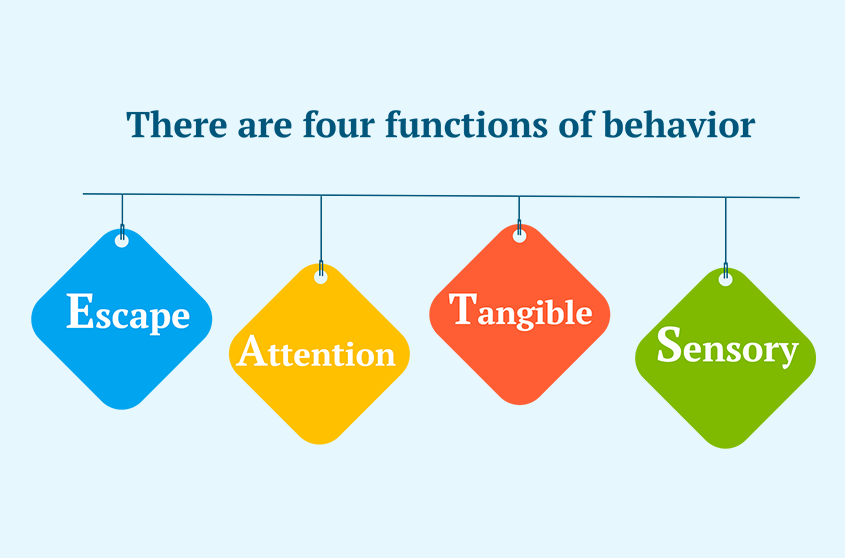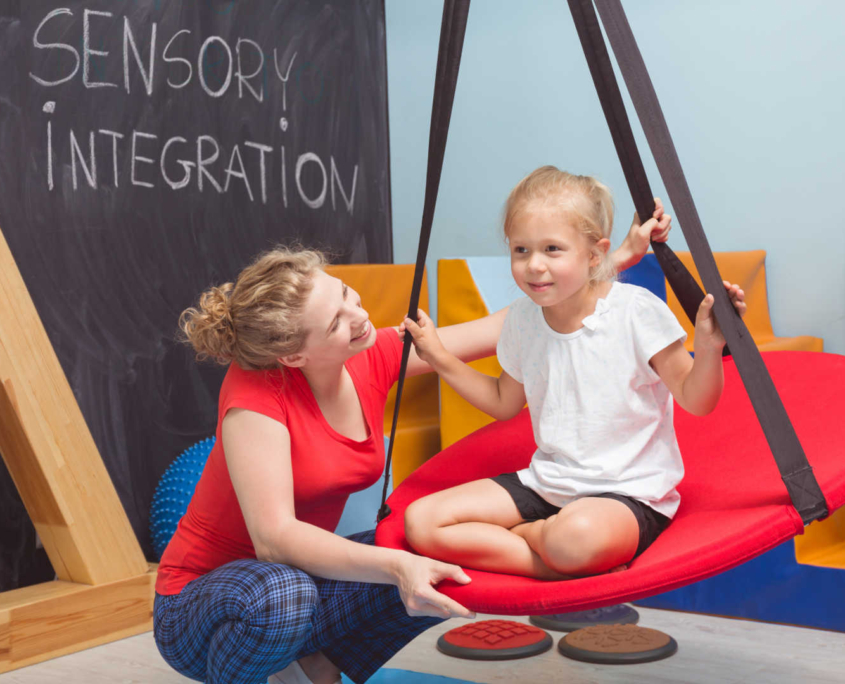What are the 4 Behavior Functions of ABA Therapy?

There are four categories of Behavior Functions: Sensory, Escape, Attention, and Tangible, commonly referred to as S.E.A.T.
When going to an ABA Therapist, they will evaluate a child and put their different behaviors into one of four behavior functions or behavior categories. They are as follows:
This helps the therapist to identify a behavior and a reason the behavior may occur, and then make a plan to either redirect the behavior when it occurs or use other tools within ABA therapy to replace the behavior with a more desired one. Therapists will work with both the parents/guardians as well as observe the child to determine behavior.
By singling out instances of a behavior they can determine where a behavior may occur in a category. For example, if a child asks for a cookie and they are given one, they are likely to ask for one again. An ABA therapist would place this scenario into ‘Access to Tangibles’ as the child is getting the physical cookie to have when asked.

# 1 Behavior Functions of ABA Therapy: Sensory Stimulation
This is when a child desires sensory input to help their muscular-skeletal and nervous systems to receive feedback easier. Children with autism have either under-sensitive or over-sensitive bodily awareness to normal input. For example, an itchy sweater can be annoying to an average person and they might get used it to by wearing it more often or ignoring it. However, for someone with autism that itchy sweater disrupts how they feel entirely and their body cannot process the feeling normally so it typically can cause an outburst or it can be the only thing they can think about all day.
For sensory stimulation, children with autism typically do something with repetitive movement. This helps their body receive sensory input feedback easier.
Some examples are:
- hand flapping
- rocking
- touching objects or people
- making loud noises and vocalizations
- pen tapping
- popping a toy in and out
- twirling an object back and forth
Typically, Sensory Stimulation is fine to occur unless it harms the child or those around them. If that’s the case then the ABA therapist would work to redirect the harmful sensory stimulation to something safer.
# 2 Behavior Functions of ABA Therapy: Escape
Escape behaviors occur when a child with autism is trying to avoid a task or get away from too much sensory input at once. They may actively ignore something by turning their head away or hiding their eyes. They also may leave the environment altogether by walking or running. This can pose the possibility of danger to the child or to those around them. Therefore, it is important to have a designated spot or room that a child can go to that is safe for them when they do need to escape. Many schools have a sensory room that students can escape to that aids them in re-regulating with padded walls, a swing, and other manipulatives for sensory.
In order to reduce the occurrence of escape behaviors, ABA therapy encourages positive reinforcement strategies. By providing a child with rewards and verbal praise, the therapist can encourage them to stay and complete their tasks.
Additionally, prompts and cues can be used to remind a child what they need to do or that they are supposed to stay in one place. If a child is overwhelmed by sensory input, ABA therapy can also work to reduce the intensity of such input by providing more calming activities or a quieter environment.
ABA therapists will also use prompting and fading techniques to help a child learn and retain new skills while reducing their reliance on prompts or cues from the therapist. Prompting is a commonly used ABA strategy that is often paired with fading. These two techniques work together to promote correct responses from the child. Prompting involves employing strategies to encourage accurate responses while fading involves gradually reducing the prompt as the child becomes more familiar with providing the correct response.
Finally, extinction methods are often used in ABA therapy when behavior is particularly difficult to extinguish. Such as when a child does not receive candy when throwing a tantrum, the child gradually decreases the frequency of tantrums until they cease entirely. The learned behavior of throwing tantrums has become extinct.

# 3 Behavior Functions of ABA Therapy: Access to Attention
This is when a child with autism wants attention from others. This can be especially difficult for children with autism who are non-verbal. Just with their regular peers, attention-getting behaviors can be good or not so good.
Positive attention-seeking behavior:
- by saying “Excuse me”
- politely tapping the individual
Negative attention-seeking behavior:
- crying
- screaming
- throwing objects
- hitting
- biting
An ABA therapist will work to help those not-so-good attention-seeking behaviors. For children with autism who are non-verbal, it may be beneficial to introduce an iPad or other such electronic device that acts as their words where they can ask questions, request what they want, and be able to appropriately and safely interact with those around them. Children with autism who can speak may still benefit from sheets with different visuals that can aid them in identifying what they want.
The four main behaviors that an ABA therapist might focus on with regard to attention-seeking behaviors are:
- Teach the child appropriate ways to request attention through modeling. ABA therapists will model expected behaviors and help the child learn and imitate those behaviors. This can be done through verbal and/or visual cues, depending on the child’s abilities.
- Replace inappropriate attention-seeking behavior with positive reinforcement such as verbal praise or rewards like a toy or a sticker when they do something right.
- Teach the child to recognize when they are being too demanding for attention and give them strategies to control their behavior.
- Encourage the child to participate in activities that promote social interaction and provide positive feedback for appropriate behaviors. This could include activities such as
- sports,
- art,
- music,
- puzzles,
- and more.
#4 Behavior Functions of ABA Therapy: Access to Tangibles
This is when a child with autism wants access to preferred reinforcers which can also be known as rewards. Rewards can come in many different shapes and forms:
- Toys such as blocks, cards, cars
- Food items such as chips or sweets
- Electronics such as TV, iPad, music
Just like how people may eat a sweet as a reward for a good game or completing a task, the same works for those with autism. Access to tangibles can work really well as rewards but it can also backfire and cause undesirable behavior to occur if not done properly.
When a child completes a necessary task then access to tangible things can be a great reward. For example, a child completes their morning routine of getting dressed and brushing their teeth. The parent can say “Good job! You did it all by yourself and for that, you get 15 minutes of access to watch your favorite YouTube show before breakfast.” A blend of positive statements and tangibles can help shape behaviors and motivate them to complete tasks that are requested of them.
Next time you hear an ABA therapist talk about the acronym SEAT you now know about Sensory Stimulation, Escape, Access to Attention, and Access to Tangibles. Although an ABA Therapist will interview you to learn more about your child and their behaviors. You can help identify your child’s behaviors into one of these four categories to help out. Such as knowing which sensory stimulations or tangibles your child prefers can help therapists already start to build a plan of what they can redirect when an undesirable behavior occurs.
ABA therapists help individuals with developmental disabilities, like autism, learn new skills and behaviors using evidence-based techniques. They also support families and caregivers in understanding and managing behaviors.
Unlock your child’s full potential with the help of Leafwing Center! Our team of highly trained Behavior Analysts, Assistant Behavior Analysts, and Technicians are here to provide the resources, time, and expertise needed for your child with autism to succeed in life. Together, we’ll create an individualized plan tailored to their unique needs, ensuring they thrive in any environment they encounter. Let us be your partner on this incredible journey!
Related Glossary Terms
- Avoidance Contingency
- Escape Contingency
- Escape Extinction
- Sensory Integration
- Positive Reinforcement
- Stereotypic/Repetitive Behaviors
Other Related Articles
Frequently asked questions about ABA therapy
What is ABA Therapy used for?
ABA-based therapy can be used in a multitude of areas. Currently, these interventions are used primarily with individuals living with ASD; however, their applications can be used with individuals living with pervasive developmental disorders as well as other disorders. For ASD, it can be used in effectively teaching specific skills that may not be in a child’s repertoire of skills to help him/her function better in their environment whether that be at home, school, or out in the community. In conjunction with skill acquisition programs, ABA-based interventions can also be used in addressing behavioral excesses (e.g., tantrum behaviors, aggressive behaviors, self-injurious behaviors). Lastly, it can also be utilized in parent/caregiver training.
In skill acquisition programs, a child’s repertoire of skills is assessed in the beginning phase of the services in key adaptive areas such as communication/language, self-help, social skills, and motor skills as well. Once skills to be taught are identified, a goal for each skill is developed and then addressed/taught by using ABA-based techniques to teach those important skills. Ultimately, an ABA-based therapy will facilitate a degree of maintenance (i.e., the child can still perform the learned behaviors in the absence of training/intervention over time) and generalization (i.e., the learned behaviors are observed to occur in situations different from the instructional setting). These two concepts are very important in any ABA-based intervention.
In behavior management, the challenging behaviors are assessed for their function in the beginning phase of the services. In this phase, the “why does this behavior happen in the first place?” is determined. Once known, an ABA-based therapy will be developed to not just decrease the occurrence of the behavior being addressed, but also teach the child a functionally-equivalent behavior that is socially-appropriate. For example, if a child resorts to tantrum behaviors when she is told she cannot have a specific item, she may be taught to accept an alternative or find an alternative for herself. Of course, we can only do this up to a certain point—the offering of alternatives. There comes a point when a ‘no’ means ‘no’ so the tantrum behavior will be left to run its course (i.e., to continue until it ceases). This is never easy and will take some time for parents/caregivers to get used to, but research has shown that over time and consistent application of an ABA-based behavior management program, the challenging behavior will get better.
In parent training, individuals that provide care for a child may receive customized “curriculum” that best fit their situation. A typical area covered in parent training is teaching responsible adults pertinent ABA-based concepts to help adults understand the rationale behind interventions that are being used in their child’s ABA-based services. Another area covered in parent training is teaching adults specific skill acquisition programs and/or behavior management programs that they will implement during family time. Other areas covered in parent training may be data collection, how to facilitate maintenance, how to facilitate generalization of learned skills to name a few.
There is no “one format” that will fit all children and their families’ needs. The ABA professionals you’re currently working with, with your participation, will develop an ABA-based treatment package that will best fit your child’s and your family’s needs. For more information regarding this topic, we encourage you to speak with your BCBA or reach out to us at info@leafwingcenter.org.
Who Can Benefit From ABA Therapy?
There is a common misconception that the principles of ABA are specific to Autism. This is not the case. The principles and methods of ABA are scientifically backed and can be applied to any individual. With that said, the U.S. Surgeon General and the American Psychological Association consider ABA to be an evidence based practice. Forty years of extensive literature have documented ABA therapy as an effective and successful practice to reduce problem behavior and increase skills for individuals with intellectual disabilities and Autism Spectrum Disorders (ASD). Children, teenagers, and adults with ASD can benefit from ABA therapy. Especially when started early, ABA therapy can benefit individuals by targeting challenging behaviors, attention skills, play skills, communication, motor, social, and other skills. Individuals with other developmental challenges such as ADHD or intellectual disability can benefit from ABA therapy as well. While early intervention has been demonstrated to lead to more significant treatment outcomes, there is no specific age at which ABA therapy ceases to be helpful.
Additionally, parents and caregivers of individuals living with ASD can also benefit from the principles of ABA. Depending on the needs of your loved one, the use of specified ABA techniques in addition to 1:1 services, may help produce more desirable treatment outcomes. The term “caregiver training” is common in ABA services and refers to the individualized instruction that a BCBA or ABA Supervisor provides to parents and caregivers. This typically involves a combination of individualized ABA techniques and methods parents and caregivers can use outside of 1:1 sessions to facilitate ongoing progress in specified areas.
ABA therapy can help people living with ASD, intellectual disability, and other developmental challenges achieve their goals and live higher quality lives.
What does ABA Therapy look like?
Agencies that provide ABA-based services in the home-setting are more likely to implement ABA services similarly than doing the same exact protocols or procedures. Regardless, an ABA agency under the guidance of a Board-Certified Behavior Analyst follows the same research-based theories to guide treatment that all other acceptable ABA agencies use.
ABA-based services start with a functional behavior assessment (FBA). In a nutshell, a FBA assesses why the behaviors may be happening in the first place. From there, the FBA will also determine the best way to address the difficulties using tactics that have been proven effective over time with a focus on behavioral replacement versus simple elimination of a problem behavior. The FBA will also have recommendations for other relevant skills/behaviors to be taught and parent skills that can be taught in a parent training format to name a few. From there, the intensity of the ABA-based services is determined, again, based on the clinical needs of your child. The completed FBA is then submitted to the funding source for approval.
One-on-one sessions between a behavior technician and your child will start once services are approved. The duration per session and the frequency of these sessions per week/month will all depend on how many hours your child’s ABA services have been approved for—usually, this will be the number recommended in the FBA. The sessions are used to teach identified skills/behaviors via effective teaching procedures. Another aspect of ABA-based services in the home-setting is parent training. Parent training can take many forms depending on what goals have been established during the FBA process. The number of hours dedicated for parent training is also variable and solely depends on the clinical need for it. If a 1:1 session is between a behavior technician and your child, a parent training session or appointment is between you and the case supervisor and with and without your child present, depending on the parent goal(s) identified. Parent training service’s goal is for you to be able to have ample skills/knowledge in order for you to become more effective in addressing behavioral difficulties as they occur outside of scheduled ABA sessions. Depending on the goals established, you may be required to participate in your child’s 1:1 sessions. These participations are a good way for you to practice what you have learned from the case supervisor while at the same time, having the behavior technician available to you to give you feedback as you practice on those new skills.
As mentioned in the beginning, no two ABA agencies will do the same exact thing when it comes to providing ABA services; however, good agencies will always base their practice on the same empirically-proven procedures.
How do I start ABA Therapy?
In most cases, the first item required to start ABA therapy is the individual’s autism spectrum disorder (ASD) diagnosis report. This is typically conducted by a doctor such as a psychiatrist, psychologist, or a developmental pediatrician. Most ABA therapy agencies and insurance companies will ask for a copy of this diagnosis report during the intake process as it is required to request an ABA assessment authorization from the individual’s medical insurance provider.
The second item required to start ABA therapy is a funding source. In the United States, and in cases where Medi-Cal or Medicare insurances are involved, there is a legal requirement for ABA services to be covered when there is a medical necessity (ASD diagnosis). Medi-Cal and Medicare cover all medically necessary behavioral health treatment services for beneficiaries. This typically includes children diagnosed with ASD. Since Applied Behavior Analysis is an evidence based and effective treatment for individuals with ASD, it is considered a covered treatment when medically necessary. In many cases, private insurance will also cover ABA services when medically necessary, however in these cases, it is best to speak directly with your medical insurance provider to determine the specifics of the coverage and to ensure that ABA is in fact, a covered benefit. Additionally, some families opt to pay for ABA services out-of-pocket.
The next step to starting ABA therapy is to contact an ABA provider whom you are interested in working with. Depending on your geographic location, ABA agencies exist in many cities across the United States. Your insurance carrier, local support groups, and even a thorough online search can help you find reputable and properly credentialed ABA agencies near you. Our organization, LeafWing Center, is based in southern California and is recognized for aiding people with ASD achieve their goals with the research based on applied behavior analysis.
Once you have identified the ABA provider with whom you wish to work, they should help you facilitate the next steps. These will include facilitating paperwork and authorizations with your funding source. Once the assessment process begins, a BCBA (Board Certified Behavior Analyst) or qualified Program Supervisor should get in contact with you to arrange times in which interviews with parents/caregivers and observations of your loved one can be conducted. This will help in the process of gathering important clinical information so that with your collaboration, the most effective treatment plans and goals can be established for your loved one. This process is referred to as the Functional Behavior Assessment (FBA) and is elaborated on in different blog posts on our website. With regard as to what can be expected once ABA therapy begins, please read our blog post titled: When You Start an ABA program, What Should You Reasonably Expect from Your Service Provider?



























